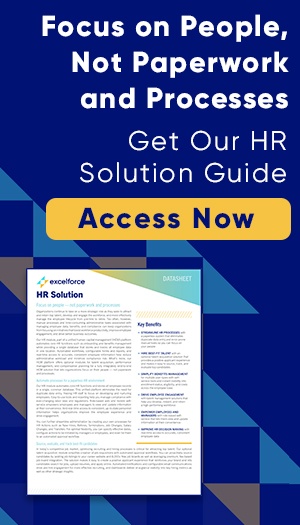Sign up for a free demo!
- Excelforce
- Industry Insights
- 3 Essential HR Metrics To Track
3 Essential HR Metrics To Track
By: Jay Mittelman
Human Resources can be a tricky aspect of your business to navigate. Having a great HR solution is key to running your business as efficiently as possible. HR metrics are essential to evaluating the efficiency of your human resource policies, programs, procedures, and initiatives. One executive, quoted in a Society for Human Resource Management article, said, “They’re measuring how the HR function is doing as a whole and also how we’re leveraging the people in the organization to maximize the performance of the company.”
You need to track the following three metrics: average time to fill, HR-to-employee ratio and turnover.
1. Average time to fill
This metric tells you the number of days between when a job is posted and when an offer is accepted. According to HireVue, an HR technology company, average time to fill ranges from 14 to 63 days, depending on the industry. Some companies fill vacancies in a much shorter time, such as the same day or within a day or two. Time-to-fill metrics can tell you whether you're actually writing great job ads and whether you’re sourcing at an appropriate pace. It also shows you how your recruitment practices are impacting your time and budget.
Formula for average time to fill: total number of days it takes to fill all roles for the period (such as per month or quarter)/total number of job openings filled.
2. HR-to-employee ratio
Research shows that human resources professionals are increasingly using this metric as they try to figure out how many HR people are needed to properly serve the organization. For example, growing companies may need to decide whether to add a benefits administrator, a recruiter, or more HR specialists to their human resources team.
The general rule is one HR person for every 100 employees. Per a 2016-2017 report by Bloomberg BNA, the median HR-to-employee ratio reached an all-time high of 1.4 HR people for every 100 employees. That said, the ideal ratio varies by company needs.
Formula for HR-to-employee ratio: total number of full-time HR employees/total number of full-time employees x 100.
3. Turnover rates
Turnover metrics can give you a bird’s-eye view into the who, why, when and how of employee departures. These metrics are crucial to lowering turnover costs, which can range from 90% to 200% of annual salary, per SHRM.
Formula for employee turnover rate: number of employees who left the company for the period (such as per month or quarter)/average number of active employees in that period x 100.
To understand the dynamics of turnover, you’ll need to dig deeper. For example, you may track:
- Voluntary turnover rate.
- Involuntary turnover rate.
- New employee turnover rate.
- Overall retention rate.
- Retention rate per manager.
- High-performer separation rate.
- Direct and indirect turnover costs.
You can go even further by measuring which employees left the company although you planned to keep them; which employees’ departures hurt, or did not hurt, the company; and which employees left for a reason that you could have, or could not have, prevented. Asking these questions are crucial to understanding the kind of candidate you can look for in the future. All this information is valuable, especially if you have recruitment software that enables you to find best fit candidates.
While there are many other useful HR metrics that you can track, these three should be on your list. And if you need any additional help understanding or learning about even more HR metrics, feel free to contact us and we'll be happy to assist you and your company's HR questions.


